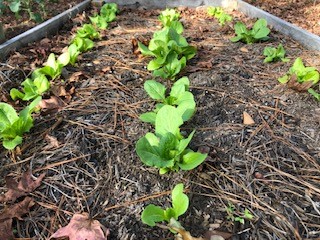Try Butterhead Lettuce for Salads
go.ncsu.edu/readext?839153
en Español / em Português
El inglés es el idioma de control de esta página. En la medida en que haya algún conflicto entre la traducción al inglés y la traducción, el inglés prevalece.
Al hacer clic en el enlace de traducción se activa un servicio de traducción gratuito para convertir la página al español. Al igual que con cualquier traducción por Internet, la conversión no es sensible al contexto y puede que no traduzca el texto en su significado original. NC State Extension no garantiza la exactitud del texto traducido. Por favor, tenga en cuenta que algunas aplicaciones y/o servicios pueden no funcionar como se espera cuando se traducen.
Português
Inglês é o idioma de controle desta página. Na medida que haja algum conflito entre o texto original em Inglês e a tradução, o Inglês prevalece.
Ao clicar no link de tradução, um serviço gratuito de tradução será ativado para converter a página para o Português. Como em qualquer tradução pela internet, a conversão não é sensivel ao contexto e pode não ocorrer a tradução para o significado orginal. O serviço de Extensão da Carolina do Norte (NC State Extension) não garante a exatidão do texto traduzido. Por favor, observe que algumas funções ou serviços podem não funcionar como esperado após a tradução.
English
English is the controlling language of this page. To the extent there is any conflict between the English text and the translation, English controls.
Clicking on the translation link activates a free translation service to convert the page to Spanish. As with any Internet translation, the conversion is not context-sensitive and may not translate the text to its original meaning. NC State Extension does not guarantee the accuracy of the translated text. Please note that some applications and/or services may not function as expected when translated.
Collapse ▲Butterhead lettuce (Lactuca sativa) produces small heads which are perfect for salads or sandwiches with their soft, green, sweet, bunched, and tender leaves. Check out local growers, catalogs and online for lots of heirloom varieties to choose from. In Carteret County, sow in early spring and late fall, full sun preferably. Plants should be spaced 8 inches apart, ¼ depth and in 12 inch rows. Seedlings should emerge in 7-10 days. It will reach maturity in approximately 75 days, but may be longer if growing through the fall and early winter. At maturity, plants are about 9-15 inches in height and 6 inches wide. Lettuce can also be grown in containers although it requires deep watering at least weekly and lots of nitrogen.

Butterhead Lettuce, Photo by: Michael Thomas.
Harvest lettuce early to avoid bitter or tough leaves by picking the leaves you want. Also, harvesting in the morning when the leaves are moist is preferred. Lettuce can be susceptible to bugs such as caterpillars, slugs and snails, but also animals such as rabbits. Powdery mildew and mosaic virus can also be issues. Regular inspection and cleaning and trimming of damaged leaves will help contain these issues.
If there is a particular plant that you have an issue with or need help identifying, visit North Carolina Cooperative Extension or call (252) 222-6352.
Written by Michael W. Thomas, Extension Master Gardener Volunteer – Carteret County




